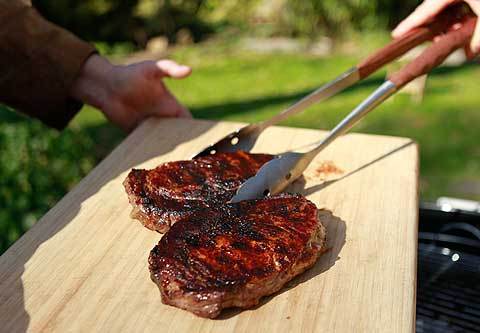This weekend is the time for grilling and we’ve had some requests to provide a few grilling tips for your River Cottage Farm Grass Fed steaks. Cooking over a live flame puts on a good show, and grilling steaks is a cakewalk once you’ve done it more than once. At our house, Brayden is the grill master but I have the scientist’s mind so while he flips and manages the timer I am explaining in exact scientific terms all the wonderful things occurring within the proteins and fats.
When grilling grass fed meats a few basic tips and the right tools will get you where you want to go; a deliciously seared, tender and juicy steak. Always start with a great grass-fed steak, a hot grill of your choice (charcoal with briquettes, hardwood charcoal or gas) and a few essential tools: a timer, tongs for flipping and a platter for the cooked steaks. A digital instant-read thermometer takes the guesswork out of determining the moment your steak is within five degrees of your ideal serving temperature. (The internal temperature will continue to climb after you remove the steak from the grill; this is called carry-over cooking). Stay relaxed and attentive as you monitor those searing steaks and you’ll be a hero of the grill.
 Marinating your steaks for even an hour will infuse considerable flavor and add extra moisture to the finished steak. A very good, simple marinade is olive oil, a couple of cloves of garlic, and some oregano or rosemary. Take the steaks out to dry on paper towels and whisk in some honey. Use the honey marinade as a mop while the steaks cook on the grill.Here is one of our favorite steak recipes. What I like about this recipes is the fact that the meat is interchangeable so use whatever you have on hand and the result will be the same. I speak here from experience. When called upon by a magazine to showcase our steaks and my favorite recipe for grilling I submitted my Beef Tenderloin Steaks with Blue Cheese Topping. After finding out that I actually had to grill the steaks for the cover I cooked 15 different steaks just to be certain that I had one perfectly grilled steak. With just a few tweaks the recipe became Grilled NY Strip with Blue Cheese Topping! After the photo shoot we all chowed down on lamb chops, NY Strip, Rib Eye and Porterhouse with Blue Cheese Topping.Enjoy
Marinating your steaks for even an hour will infuse considerable flavor and add extra moisture to the finished steak. A very good, simple marinade is olive oil, a couple of cloves of garlic, and some oregano or rosemary. Take the steaks out to dry on paper towels and whisk in some honey. Use the honey marinade as a mop while the steaks cook on the grill.Here is one of our favorite steak recipes. What I like about this recipes is the fact that the meat is interchangeable so use whatever you have on hand and the result will be the same. I speak here from experience. When called upon by a magazine to showcase our steaks and my favorite recipe for grilling I submitted my Beef Tenderloin Steaks with Blue Cheese Topping. After finding out that I actually had to grill the steaks for the cover I cooked 15 different steaks just to be certain that I had one perfectly grilled steak. With just a few tweaks the recipe became Grilled NY Strip with Blue Cheese Topping! After the photo shoot we all chowed down on lamb chops, NY Strip, Rib Eye and Porterhouse with Blue Cheese Topping.Enjoy Beef Tenderloin Steaks with Blue Cheese Topping
Beef Tenderloin Steaks with Blue Cheese Topping
Ingredients:
4 (1 1/2-inch thick) filet steaks
(NY Strip, Rib Eye, Lamb Chops, Porterhouse also work)
Olive oil, as needed
1 teaspoon coarsely cracked black pepper
Sea Salt,
Topping Ingredients
1 stick unsalted butter, slightly softened
1/4 cup crumbled blue cheese –
(Ludwig Farmstead Vermilion River Blue is best – Maytag works in a pinch)
2 teaspoons finely chopped fresh thyme
Salt and freshly cracked black pepper
Chopped parsley for garnish
Instructions: 1. Combine topping ingredients in small bowl. Season steaks with salt and pepper.
2. Sear steaks on a hot grill and cook until an instant read thermometer reads 125 – 130 (See guide below). One to two minutes before steaks are done, top evenly with topping. 3. Sprinkle with parsley. Makes 4 servings.

